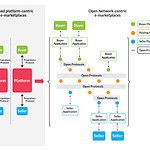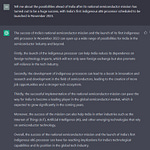Cyberpolitik #1: Wanted - Greater scrutiny of content takedown orders
— Prateek Waghre
Last week, reports suggested that the Union Government of India had issued an order to ban 54 apps. This would constitute the fifth such instance since June 2020 (when TikTok and 58 other apps were blocked), three of which have been accompanied by press releases.
June 2020: 59 apps (accompanied by a press release)
July 2020: 47 (not accompanied by a press release)
September 2020: 118 apps aka PUBG ban (accompanied by a press release)
November 2020: 43 apps (accompanied by a press release)
At the time of writing, this latest instance has not been accompanied by a press release. In response to queries from the press, Google has indicated that it received orders to remove apps from the Play Store. In a video discussion, Sarvesh Mathi of Medianama noted the potential existence of a pattern - in that the July 2020 instance (which did not come with a press release) mainly covered cloned/renamed apps. That appears to be the case here too. A senior official from the ministry was quoted as saying:
“Many of the apps from the stable of Tencent and Alibaba, have changed hands to hide ownership. They are also being hosted out of countries like Hong Kong or Singapore, but the data was ultimately going to servers in Chinese destinations,” said a senior official while pointing out that “even apps such as ByteDance-owned TikTok and Tencent’s WeChat were available for download through alternative means such as APK files, and the government has taken cognizance of it.”
These orders have been passed under Section 69A of India's IT Act.
There have been other recent instances where content takedown orders were accompanied by press releases too.
In December 2021: 20 YouTube channels and 2 websites operated by groups from Pakistan as per a press release.
In January 2022: 35 YouTube channels and 2 websites operated by groups from Pakistan as per a press release.
These orders have been issued under the emergency rules included in the IT Rules and Digital Media Ethics 2021 (Rule 16).
Transparent when convenient
The Information Technology (Procedure and Safeguards for Blocking for Access of Information by Public) Rules, 2009, which specify the procedure to be used when restricting access to information, include a clause for confidentiality. There have been instances in the past when the fact that blocking orders were issued were only discovered because one of the companies that received them voluntarily disclosed them via the Lumen Database. In my opinion, when such orders are accompanied by press releases or information is provided by unnamed sources to the press, one should assume it happens because it is convenient to do so. This is perhaps why Google’s suggested “win-win for both sides” in a meeting between officials from the Ministry of Information and Broadcasting and representatives from Google, Facebook, and Twitter, as reported by Reuters, was not viewed as one.
Executives from Google told the I&B officials that one way to resolve that was for the ministry to avoid making takedown decisions public. The firms could work with the government and act on the alleged fake content, which could be a win-win for both sides, Google said, according to one of the sources.
The idea was summarily rejected by the government officials, who said the takedowns also publicise how the companies weren't doing enough to tackle fake news on their own, the person said.
The proverbial house, as they say, always wins.
A higher burden of proof and greater scrutiny
As Raman Chima points out, such orders are escaping scrutiny. And while it is not the intention of this author to bat for TikTok in any way whatsoever - the charges against it do not seem to have been substantiated. And while much of the cheerleading surrounding the move played up the economic impact it would have, TikTok has since surpassed 1 billion active users - while creators from India appear to have been denied a global audience.
The two emergency takedown orders issued in December 2021 and January 2022 also present an interesting case study. While both press releases indicate aggregate view counts and membership numbers across the YouTube channels listed - they do not explain what portion of those views were from India - as YouTube view counts do not break down viewership numbers by country. In attempting to highlight the impact of these 'digital strikes', the 2 press releases also include a 'combined subscriber base'. However, these numbers appear to be just a total of the subscriber numbers across the listed channels, without accounting for the (highly likely) possibility that one account is subscribed to more than one channel - meaning that the number overstates the real 'combined subscriber base' and the impact. These are the kind of elementary questions that would be asked if such orders were being subjected to basic levels of scrutiny.
Matsyanyaaya: Understanding China’s High-Tech Espionage Efforts
— Arjun Gargeyas
An interesting aspect of the November 2021 Department of Defense (DOD) report on China’s military was the focus on Beijing’s industrial espionage efforts on certain advanced technologies which the government thinks holds the key to enhancing the quality of their military systems. There are four main areas that the PLA is targeting and it is imperative to understand how these technologies can help develop advanced military systems.
First, the report mentions specialised integrated circuits (ICs) specifically meant for military use as one of China’s targets. This includes radiation-hardened ICs and monolithic microwave ICs, which are tailor-made for withstanding military-grade conditions. These specialised electronic components consume very little power and need enhanced fabrication processing to immunise the system against any kind of latch-up when exposed to extreme radiation or temperature. Their applications can range from nuclear warheads to any weapons or platforms that might be subject to radiation effects from nuclear attacks. Due to the complex method of manufacturing these components, the technology remains concentrated with certain players only which makes it a lucrative target for China.
Second, the focus on memory chipsets in the report has raised eyebrows on China’s potential military plans. The growth of non-volatile (NV) memory, which are memory chips that can retain the data stored in it even after the removal of power supply, has created interest in the possibility of using such components in military vehicles. The two key factors of retention ability and endurance remain on the higher side for these kinds of chipsets. Military electronics manufacturers now advocate the use of NV memory chips (like NVSRAMs) in military equipment due to their faster read and write speeds, long-term data storage, and high reliability. An application where these chips are in massive demand is in the development of autonomous weapon systems. High-grade memory chips being a potential target of Chinese espionage efforts opens up a possibility of new weapon systems being developed by their forces for modernising the existing military systems.
Third, the use of sensors to develop tools like accelerometers and gyroscopes is on China’s radar. These components are used for adequate measurements and sensing especially in building tactical weapon systems. Gyroscopes, especially, have been crucial in the transition of low to high-grade precision and navigation systems. They have been used in long-range missiles for precision guidance as well as in improving the accuracy of the armed forces’ navigation systems. China’s interest in these devices validates that tracking, detection, and accurate sensing remains absolutely critical during warfare. New technologies have also improved the quality of devices like accelerometers that are now used by uncrewed military vehicles. The sensors in the accelerometers help in providing precise data on additional parameters like wind speed, temperature, and physical strain movement for improving the lifespan of the vehicle. It would be a major development if China manages to acquire such technology that would significantly improve the efficiency and effectiveness of their forces.
Finally, there are mentions of advanced communication systems specialising in electronic warfare being one of China’s foremost high-tech espionage targets. A specific area of these systems that the Chinese are looking to develop technical expertise is in military communication jamming equipment. When deployed, these jamming systems help defence forces in gaining a crucial advantage in the electronic warfare domain by preventing any wireless communications from taking place on the battlefield. It is no surprise that China is looking to focus on jamming systems as a way to disrupt any sort of communication between the opponent’s control towers and the ground. The possession of modern electronic warfare systems has become one of China’s priorities in its pursuit of military technologisation which can be severely detrimental to its foes.
China’s recent border skirmishes with India have brought technology and its importance in building robust and secure military systems into the limelight. The DOD report has clearly outlined what the Chinese might be going after when looking to build a stronger and better force. It is essential that counter intelligence and intellectual property protection remain India’s and other technologically advanced states’ priority to ensure that these critical technologies stay out of the hands of the Chinese military.
Cyberpolitik #2: An Indian perspective on Online Harms on DCNs
— Sapni G K
The land of technology regulation is one that never stops giving. Every edition of this newsletter has enough thought on policy and regulatory measures to leave observers amused. Newer ideas (sometimes beneficial, often not) have had a sustained presence here. In the land of cyberpolitik, the hue and cry for "regulation of the internet" has been a political moot point for over a year now, thanks to Jan 6, 2021 incident in the US Capitol. Yet, the claims of the internet and its most prominent avatar - social media - being the "wild west" is insincere. It is a sentiment that has caught the attention and sympathies of regulators and the public alike, across the globe.
Readers would recollect our inquiries into this space, as has been detailed earlier here and here. Our inquiries into the governance of Digital Communication Networks (DCNs) previously looked at harms and benefits. We defined DCNs as composite entities which had the components of capability, operator, and networks. This time around, I looked at the current legal framework on online harms on DCNs in India. I define online harms as a set of actions that can occur on DCNs that can cause legal injuries to users, whether individuals or groups of individuals. This is distinct from the approaches taken by Australia and the UK, where proposals attempt to regulate the entirety of the internet from the perspective of addressing harms. The framing of the debate on online harms on DCNs often ignores available remedies that can adequately address many legal injuries that occur on DCNs, paving the way for censorship.
In an attempt to exhaustively study these remedies, I categorised identifiable online harms as clearly defined by the law and harms having a less clear definition. Claims that certain legal injuries are not actionable simply because there are no laws governing them appear insincere. The document identifies that many incidents could still be remedied by the law currently in place. An innovative interpretation of the law can be useful in cases where ambiguity persists to help victims get speedy justice for legal injuries that occur on DCNs. The big picture shows that these long-established provisions have their fair share of drawbacks that need to be remedied. However, these have been moulded for the better through judicial interpretation and practical implementation over the years. The conversation about changing the regulatory landscape around DCNs is progressing in India. At this juncture, it is critical to take note of the system that is currently in place. As a frontier for the exercise of the freedom of speech and expression, any change in the framework regulating this space should be wary of the risks of overregulation and censorship.
Read the full issue paper as a PDF here.
This is a work in progress, as part of our investigations into the ecosystem of DCNs. If you have thoughts/comments on the same, do reach out via Twitter DMs (@SapniGK) or email me (<FirstName> AT takshashila.org.in).
Our Reading Menu
[Blog] How Cambodia’s Internet gateway will harm the Internet by Adrian Wan and Charles Mok, Internet Society
[Opinion] Regulators are Playing a Dangerous Game on the Internet by Carey Lening
[Article] A recent spy case shows how China has been able to pull off its whirlwind military modernization by Stavros Atlamazoglou
[Blog] DoD's 2021 China Military Power Report: How Advances in AI and Emerging Technologies Will Shape China’s Military by Adam Segal













Share this post